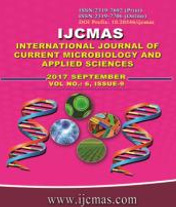


 National Academy of Agricultural Sciences (NAAS)
National Academy of Agricultural Sciences (NAAS)

|
PRINT ISSN : 2319-7692
Online ISSN : 2319-7706 Issues : 12 per year Publisher : Excellent Publishers Email : editorijcmas@gmail.com / submit@ijcmas.com Editor-in-chief: Dr.M.Prakash Index Copernicus ICV 2018: 95.39 NAAS RATING 2020: 5.38 |
Post-harvest biochemical changes occurring in fruits of three commercial varieties of pear (Patharnakh, Kashmirinakh and Baggugosha) stored under zero energy cool chamber (ZECC) (23.2±3°C and RH 90-95%) and at normal room temperature (32±4°C and RH 70-75%) conditions were assessed in the post-harvest Laboratory of the Department of Horticulture at CCS HAU, Hisar. Quality of fruits packed in polyethylene (PE 0.01 and 0.05 mm thickness) bags of individual fruit packing (IFP) and 1.0 kg capacity and corrugated fiber board (CFB) boxes was examined on alternate day basis up to 10th day of storage. Irrespective of packaging treatments, a continuous decrease in acidity and ascorbic acid contents of fruits was noticed with the passage of storage time, whereas TSS and sugar contents rose gradually with the advancement of storage period. Lower TSS (11.6%) was recorded in Patharnakh fruits packed in PE 0.05 mm of IFP at zero energy chamber (ZEC) storage and maximum (13.9%) was showed by Kashmirinakh under control condition. Maximum titrable acidity (0.46%) measured in Patharnakh stored at ZEC and having individual fruit packs in PE 0.01mm was at par with PE 0.05mm of IFP, while fruits of Kashmirinakh under control treatment showed lowest acidity (0.25%). The non-reducing, reducing and total sugar contents of fruits were not affected by packaging treatments. Conclusively, the fruits of all three varieties of pear packed in PE 0.05 or 0.01mm of individual fruit packing and stored at ZEC effectively maintained quality parameters, hence were marked best treatments. However, maximum degradation of fruits was observed in corrugated fiber board boxes stored at the room temperature.
 |
 |
 |
 |
 |